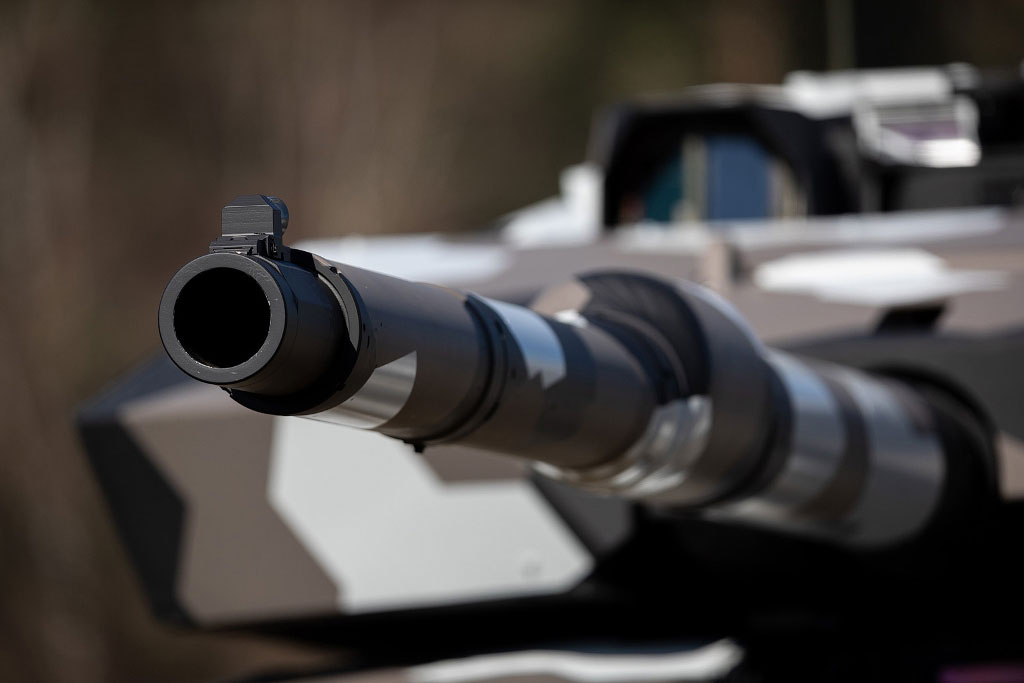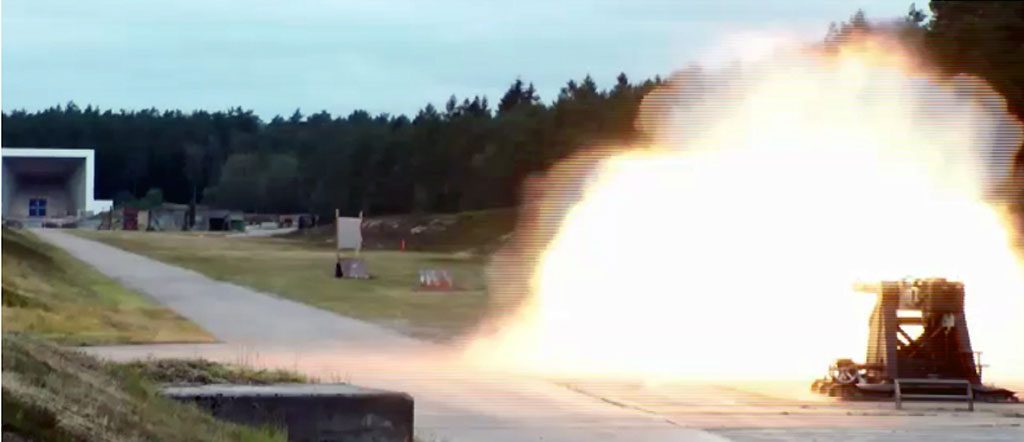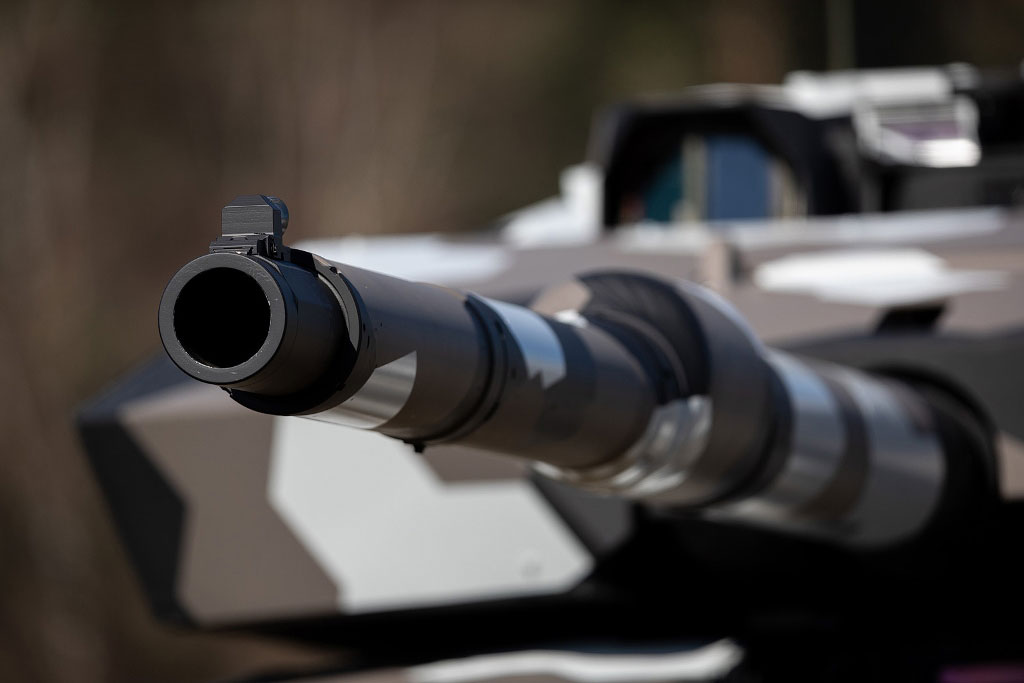
By Paolo Valpolini
While the appearance of the Russian T-14 Armata tank in the 2015 May Parade has definitely triggered considerations on future tank armaments requirements in the western world, penetrating the T-14 having become the benchmark, it is safe to say that the slow deployment of that weapon system makes the current threat still represented by the tanks available in numbers in Russian Army armoured formations such as the T-90M Proryv, the T-80 BVM and the T-72 B3M. This picture emerged well from the briefing provided by Rheinmetall on its developments in the tank guns field, the two speakers being Christoph Henselmann, Senior Vice-President and Head of Portfolio Tank Main Armament, and Moritz Walter, Product Manager 130 mm, both based in Unterlüss.
The western knowledge about the Armata MBT layered protection is still incomplete, while the protection level of the three in-service tanks is much better known, which is not true for that of the latest Chinese MBTs. “We consider the T-14 more an available technology rather than a real threat,” Moritz Walter says, confirming that real worries come nowadays from in-service systems. This has led Rheinmetall to a dual approach; on one hand the upgrade of the 120 mm smoothbore weapon system performances, and on the other the development of a bigger calibre gun, the 130 mm smoothbore demonstrator having been exhibited at Eurosatory 2016.
New 120 mm gun and ammunition; a 20% performance increase in the coming years
05/03/2021 120 mm, APFSDS, DM73, KE2020Neo, Lepard 2A7V, RheinmetallWhile Rheinmetall’s new 120 mm smoothbore gun, known as L55A1, is already available and is in series production for Germany, Norway and Hungary, fitted to the Leopard 2A7V MBT, the second element that will bring increased performances, the new APFSDS round, has still to come. As for the gun, Rheinmetall released the pressure differences between the L44 gun and the L55A1, which feature the same chamber volume that is of approximately 10 litres. The Extreme Service Condition Pressure (ESCP) is raised from 672 to 700 MPa, the Permissible Maximum Pressure (PMP) from 710 to 735 MPa, and the Design Pressure from 740 to 760 MPa. This pressure increase is vital to obtain the performances increases that the two rounds under development will bring with them.
The first one to enter service will be the DM73, which should reach qualification by year-end and will ensure an 8% performance increase over current DM53/DM63 rounds. However the round that will “squeeze” all the remaining growth potential from the 120 mm smoothbore weapon system will be the KE2020Neo; while the DM73 is an upgraded version of previous rounds, this one is a brand new development which qualification should start in 2024 to be completed by 2026, when it will become available on the market. The forecasted increase in performances should reach 20% compared to current armour piercing ammunition.
Why 130 mm and not a bigger calibre?
05/03/2021 130 mm, APFSDS, MGCS, RheinmetallWhile in the interim Rheinmetall aims at improving 120 mm performances, looking further ahead in 2016 the company exhibited in Paris its 130 mm solution, showing both the gun with a 6.6 meters long barrel, and the related APFSDS ammunition, which of course raised considerable interest. This solution does not has yet an endorsement by a potential customer; the “130” magic number is thus not the result of a requirement, but comes from a thorough analysis led the Düsseldorf-based group to orient itself towards a new calibre, and it is being proposed for the Main Ground Combat System (MGCS), or at least for its heavy armed variant, the MGCS encompassing more than one effector.
“When in 2016 we exhibited our firing demonstrator we declared that the 8% in calibre increase would have led to a 50% in performances increase,” Christoph Henselmann points out, “our aim being to bring to the target at least 50% more energy than current 120 mm rounds.” Since that date, he explains, Rheinmetall developed an expert tool that allows taking in count 50 parameters, three of them fixed, the remaining 47 variable. A tank gun is not a stand-alone system and it must cope with a series of system constraints, that in the end make the design work what Mr. Henselmann defined “an optimisation of technical compromises,” clarifying that the assumption “bigger is always better” is not in fact true.
The two key parameters for effectiveness are the aforementioned energy that reaches the target, and the accuracy at a specific combat distance, the latter requirement for future MBTs being the double compared to current tanks, so it will be necessary to hit a target with utmost accuracy at 5 km distance. A nice challenge especially on moving targets, as the flight time will be nearly the double. Among limiting factors for the gun we find i.e. weight, in the future the aim is to have systems not exceeding the MLC60 class limit, as well as turret protection, which is required against 125 mm APFSDS rounds. “Three system interface of major importance are the turret ring diameter, the recoil force and the barrel length,” Mr. Henselmann says, the diameter influencing the vehicle width and the trunnion position, the recoil forces has an impact on many aspects of the tank, not least the weight, and might bring to the use of a muzzle brake “the muzzle brake being not an advantage if you aim at optimising the accuracy of the weapon,” he underlines. As for the barrel length the most obvious impact is on the vehicle mobility, while on the gun side it influences many aspects among which the recoil force, the hit probability, the unbalance of the weapon system, the achievable muzzle energy and gas pressure. “As the result of our simulations, we carried out over 1,100 of them which considering three fixed and 47 variable data brings to over 55,000 data used for assessments, that among other showed that not all calibres fit to every barrel length.”

Christoph Henselmann states that following the R&D work done, it is quite clear that in the next 20-25 years the APFSDS round will remain the ammunition of choice for tanks against tanks firefights. “The subcalibre will stay as the best option, as it reaches the target very quickly, it is extremely accurate and the only way to defeat it is by physically destroying it.” While this is true, the APFSDS concept is far than optimal as less than 20% of the energy generated in the chamber will reach the target, he explains. Gas heat loss represents 72% of the energy loss, sabot mass 9% (for a 120 mm round) while air drag accounts for a further 3%, which means that only a mere 16% of the chemical energy generated in the chamber is brought to bear on the target. “We must therefore look at what we can optimise, and the gun calibre itself, when talking of penetrators which have a diameter of 20-30 mm has a minor importance, and by the way increasing the calibre means increasing the sabot mass, adding therefore to the loss of energy,” he explains.
He also stresses that what has to be optimised is the chamber volume, which led to the 50% increase compared to the 120 mm in the first 130 mm demonstrator. According to Rheinmetall analysis, Depleted Uranium (DU) rounds, which have an edge in current energy scenarios mostly thanks to their selfsharpening shearing capability, have reached the limit, and with the increasing energy, what Mr. Henselmann referred to as the “10 MJ scenario”, the situation should reverse with an advantage for tungsten penetrators over DU ones. It is to note that Rheinmetall aims at reaching 13-14 MJ impact energy with the 120 mm APFSDS rounds currently under development. An interesting note is that he admits that neither of the penetrators, Tungsten and DU, have been tested against the latest Russian Relikt explosive reactive armour, which apparently detonates on radar command before being hit by the incoming round.
The development work 2016-2020
05/03/2021 130 mm, autoloader, RheinmetallConsidering the development timeline of the MGCS, and knowing that developing a weapon system such as a new tank gun with its ammunition takes around 10 years, the Rheinmetall team based at Unterlüss started an intense test and development work as soon as the 130 mm demonstrator was back from Eurosatory in mid-2016. The first task was to verify the increase of performances, over 50% compared to 120 mm systems, the accuracy, and the compatibility with the weight limit considered for future MBTs. Penetration performances were assessed against NATO targets representing current threats (each costing 45,000 €), simulations being carried out shooting at 100 meters distance while reducing the charge to simulate a 1,000 meters range. As for accuracy tests, “eight rounds fall in an A3 [297 × 420 mm] sheet since the beginning of the development,” Christoph Henselmann unveils, adding that this was much better than the initial results in the 120 mm development programme. Rheinmetall engineers have a clear idea on how to proceed to further improve accuracy, “which might even bring us to downsize those solutions to further optimise existing 120 mm guns.”

From 2016 until now much effort was put in analysing data obtained with the aforementioned expert tool, in carrying out several live firing campaigns, optimising internal ballistic, the main effort being as said improving precision. Another key element was developing the autoloader, the adoption of such a system leading to a complete redesign of the breech block. This included the production of two new prototype weapons of new design, fitted with a bore evacuator, as Rheinmetall wants to have the option of a gun system apt to be used also in manned turrets. The company carried out a thorough market study on autoloaders and assessed that the most suitable existing system was produced in Southern Asia (not South Korea), Rheinmetall starting discussions with that company to find an agreement for a common development. However limits in transfer of technology from that country would not allow to meet the gun system development timeline, therefore in mid-2017 it was decided to develop the autoloader in-house, exploiting the skills of Rheinmetall Air Defence in the medium calibre field. The Swiss-based branch of the company accepted to expand its expertise into large calibre systems, and according to Mr. Walter the development went on in a very productive way bringing to the development of a functional demonstrator in the 2018-19 timeframe. “The only problem will be to convince customers that with an unmanned turret all rounds must be hosted in the turret, which means that 20-22 rounds will be available, as a bigger ammunition magazine for the autoloader would not be system compatible in terms of turret dimensions and hence added armour weight,” Christoph Henselmann explains, and this means less than half the available rounds on current four-man crew tanks. “Since early 2020 the autoloader has been transferred to Unterlüss and has been connected to the gun for testing, and in fall 2020 it was used on the firing rig for live firing. “We still see some challenges in its development, but we are not facing major hurdles,” Mr. Henselmann says, explaining that problems should be overcome to cope with the MGCS development timeframe.
Comparing pressure levels in the L55A1 gun and in the 130 mm L52 prototype, Extreme Service Condition Pressure climbs from 700 to 800 MPa, Permissible Maximum Pressure from 735 to 850 MPa, Design Pressure reaching 880 MPa compared to the 760 MPa of the 120 mm system, an average increase of 15%, with a chamber volume of “15+X” litres compared to the 10.2 litres of the 120 mm solution, the “X” leaving the door open to further refinements. The higher pressure of course requires the use of different material as all components, including ammunition elements such as primers, have to be pressure-hardened to withstand new operating pressures.
The way ahead
05/03/2021 130 mm, autoloader, Challenger 2, MGCS, Nexter, OMT, Rheinmetall, US ArmyShifting from technology to market requirements, Moritz Walter points out that Rheinmetall’s analysis shows that for newly built MBTs the unmanned turret solution should be the preferred option, while for current MBTs upgrade the manned one is definitely the most probable. That said, the upgrade option would definitely require a wholly new turret, as the 130 mm gun fitted with its autoloader that would not fit in existing turrets.
Christoph Henselmann also clarifies the appearance of the 130 mm on a video showing a Challenger 2 fitted with the new gun. “In April 2020 we had a window of opportunity when the Challenger 2 was in Unterlüss and no further tests were planned, to install the 130 mm on it, following the clearance from the UK customer. The British tank is a little wider than the Leopard 2, making things easier,” he says. Within the limited three weeks time the work concentrated on verifying how the 130 mm gun is well balanced inside a current 120 mm turret, checking stabilisation.
The main objective for Rheinmetall is the MGCS programme, in which the 130 mm competes against Nexter’s 140 mm proposal. “We consider that currently the overall 130 mm system has a TRL 2-3, the weapon more towards 3 while the autoloader being closer to 2,” Christoph Henselmann says, explaining that in February 2021 Rheinmetall started for the first time direct negotiation between the industries of both France and Germany. “In two years time, in late 2022, we expect the bi-national customer to decide which will be the main armament calibre, but simultaneously we are working on an upgrade solution for in-service 120 mm platforms,” he adds, stressing that the weapon system for manned turrets will not be completely identical to the one being proposed for the MGCS, the fitting of the 130 mm gun in a manned turret being less optimised that in an unmanned one, thus requiring some adaptations.
Rheinmetall also maintains a close eye on developments ongoing over the pound, and has already presented its solution to the US Army, as a potential candidate for what is currently referred to as Optionally Manned Tank.
“Both 130 mm systems will reach TRL 6 in the mid of the current decade, allowing for qualification of the gun system inside the weapon system,” he announces. “At this stage, although the development is not completed, we can safely say that the 130 mm allows a considerable increase in performances even at longer combat ranges, and we are more than confident that we are able to fulfil the requirements to double that range,” Christoph Henselmann concludes.

What future for tank guns? The Rheinmetall view - EDR Magazine
By Paolo Valpolini While the appearance of the Russian T-14 Armata tank in the 2015 May Parade has definitely triggered



